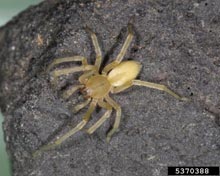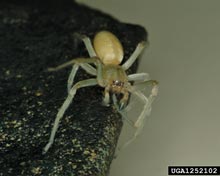
Joseph Berger

Joseph Berger
Sac Spiders
General Description
These are small to medium-sized spiders that make “sacs”- tubular webs about 1-inch long, typically positioned
between angled surfaces. The sacs are used as “retreats,” that is, the spiders rest in them by day and emerge at
night to wander in search of prey. The retreats may be abandoned after only one day’s use, so household infestations
of sac spiders are often easily identified, even without seeing the spiders, due to the prevalence of sacs
around door and window frames, in corners, and where walls and ceilings meet. Yellow sac spiders (Chiracanthium
inclusum and C. mildei) are the most common species indoors. Their bodies are about one-fourth of an
inch long and, including legs, the spiders are less than the size of a quarter. They are a pale yellowish color.
Yellow sac spiders are fast-running, nocturnal hunters that can be found from floor to ceiling in structures and
will drop on a line of silk when disturbed. They often enter homes as temperatures drop in the fall. Because they
are common indoors and may bite instinctively when touched, yellow sac spider bites may be more common
than bites from any other spider in the United States. The bite is often felt as a sharp pain. Localized redness and
swelling typically develop and dissipate within two hours. A blister like sore may appear at the bite site.
General Control
Inspect the facility on a routine basis and seal all cracks, repair screens and ensure door sweeps are installed
properly to prevent the spider from entering the facility. Monitoring traps can be used to catch the spiders when
they are entering structures or hunting. Pesticides can be effective against spiders, particularly when applied
around foundations, but in many cases control is not achieved by the use of pesticides alone.









